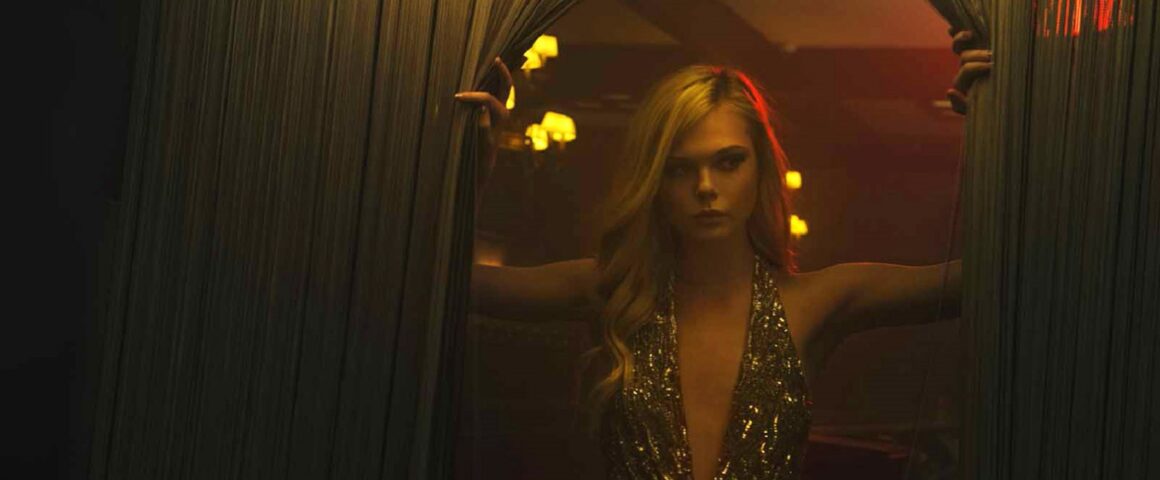Vapidity loves company. Nicolas Winding Refn is all about the surface-level pose and the finely tuned image, so it’s fitting that his latest movie, The Neon Demon, sets its sights on the modelling industry and its harshly high standards of beauty. The plan is to use horror elements to illuminate the dark corners of a world where one’s looks are everything, but Refn’s idea of how to criticize vapidity is to adopt that vapidity voraciously, as if making a vapid movie about vapid people is some form of vapidly vamped verisimilitude. With vague vampires, of course.
The superficiality of Refn’s work would be an easier and tastier pill to swallow if he simply owned his stylistic excesses and didn’t try to counter them with clunky dialogue exchanges clogged by heavy hunks of awkward exposition. He does his actors no favors in The Neon Demon, so while it should be nice that Refn has assembled a cast of mostly women after building his career on tales of rippling masculinity, it’s more disconcerting that the filmmaker reduces the characters’ conversations to catty chats about sensual lipstick names and the importance of cosmetic surgery.
Perhaps Refn considers this smarmy satire, but it’s pretty far off from “Heathers” as horror. What’s on Refn’s mind is fairly obvious, so while he probably means well in saying that we shouldn’t pit women against each other based on their looks and put them down for not looking like a 16-year-old Elle Fanning, it’s only worth a shrug of agreement if the filmmaker can’t bring anything more to the conversation.
Not having anything new to add doesn’t stop Refn from filling the air with unnecessary noise meant to clue us into simple character motivations and map Georgian teen Jesse’s unconvincing arc from impressionable ingénue to arrogant agitator. Fanning (“Maleficent”) plays Jesse as a sort of zombie with great complexion. She’s mostly stiff, ambling through the moral wasteland of L.A.’s model scene, scared but confident. Refn fawns over Fanning constantly, the camera basking in her glow as she basks in the glow of the lights and attention.
All that basking makes for pretty images in a movie all about pretty people looking pretty, but Jesse’s journey is a bust from a dramatic perspective. She finds allies and enemies alike in a makeup artist named Ruby (Jena Malone, “The Hunger Games: Mockingjay – Part 2”) and two jealous models named Gigi (Bella Heathcote, “Dark Shadows”) and Sarah (Abbey Lee, “Gods of Egypt”). Malone fares best of the bunch, if only because she’s a veteran whose shtick is so well-tuned at this point that she can overcome a bad script. Heathcote and Lee have next to nothing to do beyond sneering at Fanning, though Lee breaks through with a few subtle moments that she must have snuck behind Refn’s back.
Most of the characters are one-note caricatures, which could work in the context of a visually-driven mood piece. But Refn insists on all that dialogue, as if he really wants to penetrate the emotional elements of the experience, building up the tension between Jesse and the other girls through awkward encounters and snide remarks.
It’s a requirement of the plot as well, but for all of the time spent on developing these dramatic threads, Jesse’s transformation is jarringly abrupt, a damning example of Refn the talented visualist lamely telling us what’s happening instead of showing us. Refn wants to communicate a lot through his images, but he loses faith in either his audience or himself during the process, resorting to spelling everything out too quickly and too flatly.
Mercifully, the crumby dialogue and Refn’s simplistic storytelling are often drowned out by the absorbing acoustical artistry of Cliff Martinez’s score, which is so astonishingly awesome that it acts like an epic apology for the rest of the movie. Martinez has worked wonders with Refn before, but this is the peak of their collaboration so far, an absolutely hypnotic collection of mysterious, haunting, glittering notes that are largely responsible for creating and sustaining the eerily nightmarish tone that the movie possesses when not mired in contrived conversations.
The Neon Demon closes with a scintillating song performed by Sia and produced by Diplo, which is also one of the very best things in the whole picture. Aurally, The Neon Demon is stunning. Visually, it’s quite strong as well, so it’s strange to think of how flubbed the overall experience feels in the end. Refn probably could have turned this into a terrific silent movie, so damaging are the attempts at dialogue. It often feels like the movie wants to be free of its narrative structure, unshackled to simply explore the moody dreamscape on display.
Refn clearly has skill, but he’s ultimately a predictable provocateur probing flaccidly at his subject. He insists there’s meaning and fears we’ll miss it, then he coolly skims the dictionary definition of his themes. While he can certainly visualize vapidity, he wants so terribly to talk about it, too. What a vacuously vexing view of vanity, screaming its clichéd message as if it’s an original thought. Beauty isn’t skin deep, folks! Too bad this Refn movie is, regardless of how slick that skin may be.




'Movie Review: The Neon Demon (2016)' have 2 comments
July 12, 2016 @ 6:41 pm Nine of Five
Every Refn film can be described as style over substance. The guy uses camera tricks to hide his movies are 2 hours of emptiness.
July 12, 2016 @ 9:56 pm MasterTonic
Another great review Aaron.